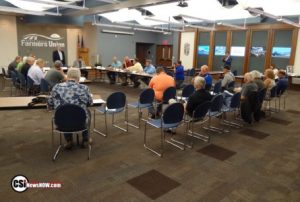 Jamestown (CSi) – Senator John Hoeven, chairman of the Agriculture Appropriations Committee and member of the Agriculture Committee, in Jamestown Friday, held a roundtable with producers, commodity groups and state officials to outline his work to provide resources and support to help the state’s farmers and ranchers impacted by severe drought.
Jamestown (CSi) – Senator John Hoeven, chairman of the Agriculture Appropriations Committee and member of the Agriculture Committee, in Jamestown Friday, held a roundtable with producers, commodity groups and state officials to outline his work to provide resources and support to help the state’s farmers and ranchers impacted by severe drought.
At the North Dakota Farmers Union Headquarter in Jamestown, Hoeven said, “Our farmers and ranchers are facing real challenges due to the drought this year. We’re working to provide them with all the tools and assistance available to ensure that they can weather the drought and continue their operations.”
Hoeven outlined drought resources he’s worked to secure, including:
Major Disaster Declaration
Hoeven pressed for approval of North Dakota’s request for a presidential disaster declaration for severe drought conditions impacting the state. The senator led a delegation letter to the president calling for additional federal assistance to be made available.
CRP Emergency Grazing and Haying
USDA recently opened additional Conservation Reserve Program (CRP) acres for emergency haying and grazing, following Hoeven’s efforts to do the same through agriculture appropriations. This builds on USDA’s approval of the senator’s request to allow emergency haying of CRP acres beginning July 16, as well as the delegation letter led by Hoeven that resulted in the opening of emergency grazing.
NRCS Wetland Restoration Acres Haying and Grazing
Hoeven also helped secure Natural Resources Conservation Service (NRCS) acres for haying and grazing. Ranchers should visit their county NRCS office to submit paperwork to access these acres, which are lands that farmers have enrolled in 30-year easements with NRCS under the Wetland Restoration Easement program.
Transportation of Hay and Livestock
The Federal Motor Carrier Safety Administration (FMCSA) has waived regulations in North Dakota allowing agriculture producers and motor carriers to more easily transport hay, feed, supplies and livestock in response to drought. Hoeven worked with the Department of Transportation to secure the waiver. More information can be found here.
The senator has also included a provision in the Senate’s Fiscal Year (FY) 2018 funding legislation to make funding available for the transportation of hay and livestock during drought conditions under the Emergency Assistance for Livestock, Honey Bees and Farm-raised Fish program (ELAP).
Livestock Forage Disaster Program
Hoeven recently announced that ranchers in counties experiencing drought in D3 or higher categories are immediately eligible for payments under the Livestock Forage Disaster program. For counties under D2 intensity, eligibility begins after eight consecutive weeks of drought. The amount received depends on:
- The intensity and length of drought experienced in the affected county.
- The estimated monthly feed cost of covered livestock or the carrying capacity of insured grazing acres, whichever is less.
Eligible producers could expect to receive payments per head of adult beef cattle of approximately $17 at the lowest level of drought to $84 at the highest level of drought. For payments based on grazing acres, payments can range from $1.40 per acre at the lowest level of drought for native acres to $28 per acre at the highest level of drought for improved acres. The payment varies based on the number of acres required to support one animal in a given county and whether it is native or improved land.
North Dakota State University Extension Service has developed a tool to help ranchers calculate their payments, which can be found here. Ranchers should contact their local Farm Service Agency (FSA) office for complete details and calculations. Further details on the Livestock Forage Disaster Program can also be found here, and county information for North Dakota can be found here at the U.S. Drought Monitor.
Ensuring Adequate Loss Adjusters
Hoeven secured a commitment from the head of the Risk Management Agency (RMA) to ensure there are loss adjustors to assess drought damage in North Dakota. The senator urged Heather Manzano, Acting RMA Administrator, to hold insurance companies to their contracts and ensure they provide adequate personnel to address claims in a timely fashion, which she committed to do. This will help prevent delays for producers facing drought and other challenges.
FSA Emergency Assistance
The USDA has since designated counties in the state as natural disaster areas due to the drought, making additional assistance available for farm and ranch operators. This includes emergency loans through FSA. FSA has also committed additional staff and resources to prevent service delays in the areas facing severe drought, a response to similar provisions Hoeven included in the FY2018 funding legislation. Ranchers in affected counties have eight months from the date of the disaster designation to apply.
In addition, USDA has provided producers with FSA loans a 12-month exemption from a requirement that they have physical control of their livestock. This exemption will allow ranchers to weather the drought by moving their livestock to feedlots or other states where they have grass before taking back physical control at a later date.
Additionally, Hoeven recently reintroduced the Capital for Farmers and Ranchers Act, legislation to increase the FSA loan guarantee amount from $1.39 million to $2.5 million and double the amount of direct loans from $300,000 to $600,000. This covers two types of loans and loan guarantees:
- Farm Operating Loans – To purchase livestock, farm equipment, feed, seed, fuel, farm chemicals and insurance and to cover other operating expenses. It can also be used for minor improvements to buildings, costs associated with land and water development, family living expenses and debt refinancing in certain circumstances.
- Farm Ownership Loans – To purchase farmland, construct or repair buildings and other fixtures, develop farmland to promote soil and water conservation and to refinance debt.












Comments are closed
Sorry, but you cannot leave a comment for this post.